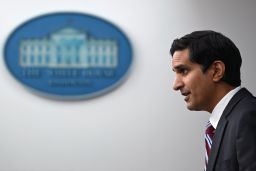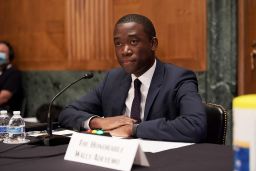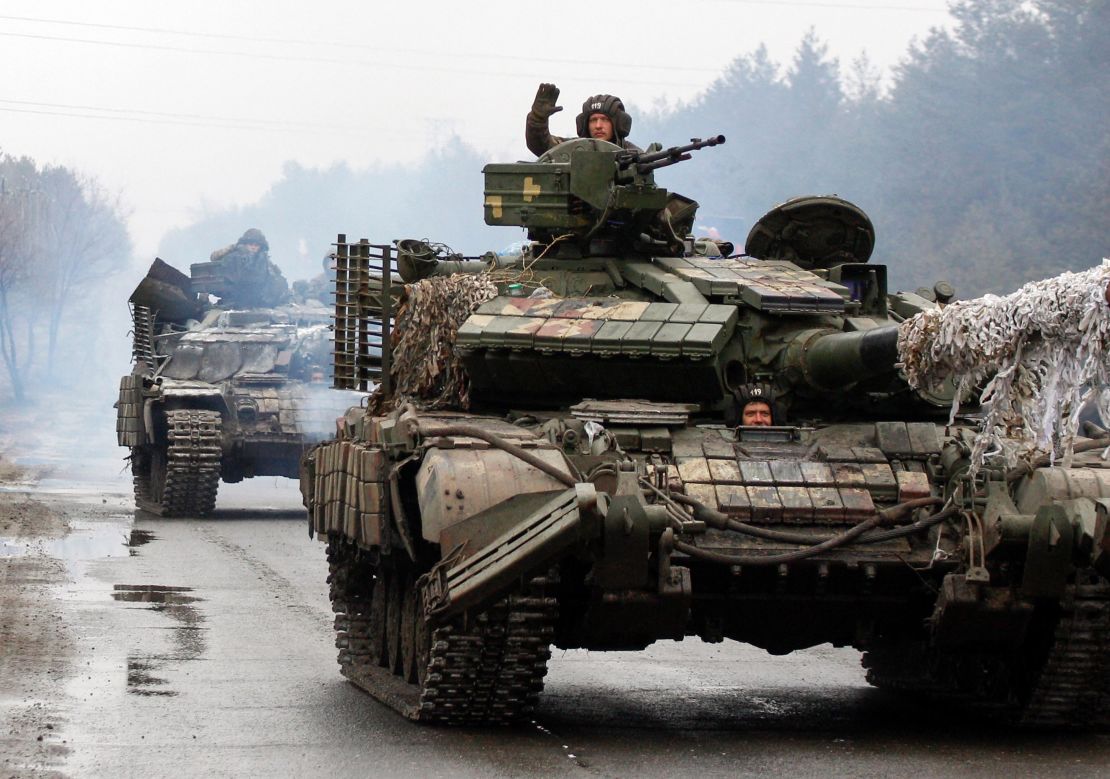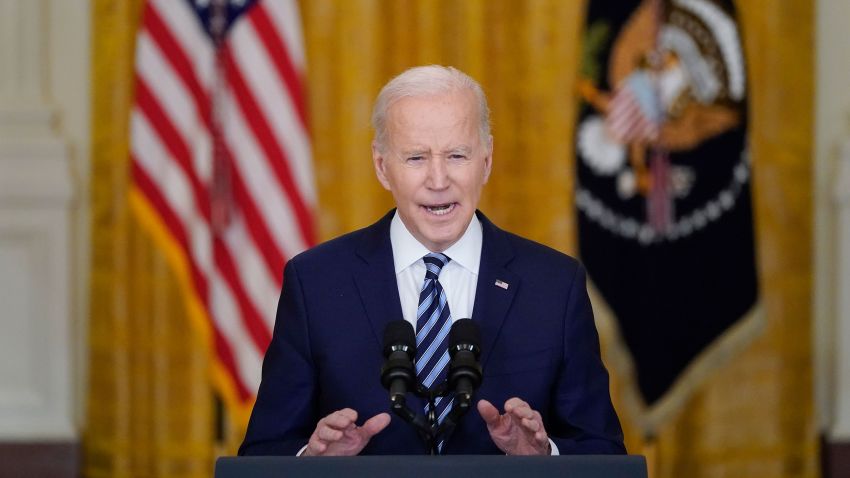The speed and ferocity of financial sanctions being deployed against Russia in response to its invasion of Ukraine are without precedent. Over the weekend, the US and its Western allies took a series of dramatic steps that just days earlier were seen as unlikely.
A number of Russian banks will soon be expelled from the SWIFT global messaging network, in many ways the backbone of global commerce. Even more significant is the commitment to target Russia’s central bank with sanctions that sever its ability to conduct transactions with Western banks.
The move would undo years of work by Russian President Vladimir Putin to sanction-proof his economy by amassing a $630 billion war chest of foreign currency reserves. If Russia’s central bank is barred from selling those reserves through foreign banks, that stockpile would essentially be rendered useless.
Russia’s economy, already grappling with its stock market’s worst week on record, an all-time low for its currency against the dollar and soaring borrowing costs, now faces a true crisis moment.
“This is not where we wanted to be, but this is Putin’s war of choice, and only Putin can decide how much more cost he is willing to bear,” a senior US administration official said. “In short, Russia has become a global, economic, and financial pariah.”
Russia’s energy exports, its biggest source of revenue, remain largely untouched, but that too is a sign of how the US is moving in lockstep with its European allies, many of whom rely on Russia for a significant amount of their oil and natural gas supplies. It also demonstrates how the alliance is leaving options on the table to use down the road.
US and European officials working on the technical details of the sanctions were in “near constant contact” over the course of the last two days, one European official said. The official described the 48-hour period as defined by “a level of determination to make this work – and get it right.”
That official said there was no sign that determination would dissipate any time soon. The images seen worldwide, along with direct conversations between European leaders and their Ukrainian counterparts, including Ukrainian President Volodymyr Zelensky, had dramatically shifted the dynamic.
After years of dissension and objections over how best to deal with Russia, in the space of just a few days the US and its Western allies have demonstrated a remarkable degree of collective resolve, something that took months of behind-the-scenes diplomacy to achieve, officials say.
Last October, as alarm spread through President Joe Biden’s national security team over classified intelligence that Russia was building up its military presence around Ukraine, a group of US officials began work on what would become the most sweeping package of sanctions ever deployed against a country with an economy as big as Russia’s.
Over the next several weeks, Biden’s public strategy to forestall an invasion moved to the forefront. It included diplomatic efforts to dissuade Russia from military action and US troop deployments to reassure Eastern European NATO allies. While Biden made clear American troops would not be deploying to Ukraine, behind the scenes, a team of economists, diplomats, finance experts and national security officials were tasked with coming up with another way to project American might.
By mid-November, officials from the White House National Security Council, as well as from the Treasury, State and Commerce Departments were engaged in an intensive effort to rally foreign allies behind the most tangible threat of action – a sweeping package of sanctions designed to isolate Putin and cripple his country’s economy.
Over dozens of calls, meetings and planning sessions, US officials spent the next few months negotiating with their foreign counterparts to join the US in a sweeping sanctions program. The work appears to have paid off. Within hours of Putin’s invasion beginning last week, more than 30 countries across four continents, comprising more than half of the world’s gross domestic product, had taken part in sanctions against Russia.
Russia’s largest banks are now severed from the global financial system. Key industrial sectors have been cut off from accessing critical technologies. Family members of top officials in Putin’s inner circle have been hit with individual sanctions, including having their US-held assets frozen.
On Friday, individual sanctions were aimed at Putin himself. By Saturday, the alliance announced its intent to trigger a calibrated version of what is widely seen as the sanctions equivalent of the “nuclear option” – expelling several Russian banks from the SWIFT global payment system.
The decision not to include SWIFT sanctions in the initial round of sanctions was done in part to placate European allies, many of which use the system to make payments for fuel from Russia, officials said.
But the continued escalation of sanctions in the days since the initial sweeping package rolled out gave a window into what officials viewed as the most critical component of the effort: a unified response. Not only would it create a robust sanctions regime, officials said, but it also created the space – and trust – to dial up the punishment if conditions warranted.
Many of the US officials involved in the effort, including Daleep Singh, Biden’s deputy national security adviser for international economics, and Wally Adeyemo, the deputy Treasury secretary, worked in the Obama administration and had helped craft sanctions against Russia the last time Putin moved on Ukraine in 2014.

The lessons learned, both in crafting a more robust package and in the importance of keeping allies on board, served as a road map for the entire push, officials said.
The process wasn’t a straight line, particularly early on when European officials were skeptical about the scale of the threat outlined by US intelligence, according to officials. Differing legal authorities and capabilities needed to be managed and massaged.
But as Russian troops and firepower amassed along the Ukrainian border, the talks gained momentum.
“As the crisis intensified, the diplomatic effort intensified,” a senior administration official told CNN.
By the first week of February, a small team of administration officials was in Europe to hammer out the final critical details as part of a delegation that stopped in the United Kingdom, France, Belgium and Germany, according to an administration official briefed on the effort.

Inside the White House, officials had become increasingly convinced in recent weeks that sanctions, which have rarely served as a singular tool to dramatically shift behavior, were unlikely to change Putin’s calculation.
“He’s done what we feared,” the official said. “But we still can – and certainly will – make this a failure for him.”
Officials say the measure of the response, both in participants and in the bite of the sanctions themselves, revealed just how much was learned eight years prior.
“We felt like coming out of it we really understood Russia’s pressure points,” the official said of how the 2014 experience shaped the approach.
Julia Friedlander, a former senior Treasury and National Security Council official, said the Obama administration’s sanctions of Russia after the 2014 invasion of Crimea “came nowhere close” to the actions the Biden administration is now taking.

And yet, as Russian forces surrounded the Ukrainian capital of Kyiv on Friday, critics contended that the Biden administration hadn’t gone far enough. Russia’s oil and gas sector, the engine of its economy, remains untouched. Russia is still allowed to participate in the SWIFT system. And, perhaps most damning to critics, the sanctions package itself wasn’t deployed until after the invasion was under way.
If it was meant to deter, or shift, Putin’s calculation, it had come up short.
“Sadly, deterrence after the fact is not deterrence at all,” said Kentucky Sen. Mitch McConnell, the US Senate’s top Republican who had been pressing the administration daily to pre-emptively launch the full scale of the sanctions package.
Administration officials say that criticism misses the overarching intent of the strategy Biden’s team pursued.
“We have purposely designed these sanctions to maximize the long-term impact on Russia and minimize the impact on the United States and our allies,” Biden said Thursday.
While markets have already demonstrated the near-term bite, officials say the full scale of the restrictions compounds the costs over time, squeezing key economic sectors and industrial capacity. The sanctions are designed to limit Putin’s options and ambitions, even as it has grown clear inside the White House that the current crisis is unlikely to end anytime soon.
“Once it starts, there’s no quick end,” a senior White House official said of the Russian invasion. “This is going to take time, and potentially quite a bit of it.”
Finding the pressure points
Putin has spent years preparing for the sanctions onslaught he now faces. He has reduced Russia’s dependence on global debt markets and built up a massive $600 billion war chest of foreign currency reserves, the fourth largest in the world. Russia’s reliance on the dollar has been minimized by a dramatic increase in holdings of euros and Chinese yuan – all meant to insulate Russia against Western sanctions.
Still, the key players crafting the US sanctions see vulnerabilities in Russia’s economy. Restrictions on foreign investment across critical industries, with a particular focus on banks, have been paired with new tools designed to expose Russia’s limited capacity to manufacture components critical to key industrial sectors.
The Treasury Department led on crafting the economic sanctions designed to go far beyond the 2014 iteration. Commerce Department officials, who have export control authorities, spearheaded an innovative addition to the overall sanctions package that would cut off Russian access to Western technology.
As European allies initially balked at the idea of kicking Russia out of SWIFT, Treasury officials focused on cutting Russia’s biggest banks off from the West. Russia’s largest bank, Sberbank, was severed from doing business on international markets. The second-largest lender, VTB Bank, was hit with full blocking sanctions that froze US assets and any US-related business entirely.
“You’re going to cause the Russian central bank over time to deplete its reserves,” said Friedlander, now the director of the Atlantic Council’s economic statecraft initiative. “It’s in a pretty good position right now, but as these banks have less and less liquidity, the central bank is going to have to prop up. You are causing in effect a banking crisis in the country.”
No more tech
A central pillar of the package are the export controls designed to sever Russia’s access to critical technologies.
In crafting their strategy, Biden administration officials sought to take an idea from the 2014 sanctions – efforts to degrade Russia’s energy production over time – and expand on them by using a more direct and potent tool to target key industries, including military, biotechnology and aerospace.
The inclusion of export controls marks an evolution in the crafting of a comprehensive economic crackdown, one designed to weave in the restrictions on a multilateral scale without precedent.
Items ranging from semiconductors and lasers to information security equipment and sensors will face restrictions. The more countries that joined, the fewer options Russia would have to backfill items it has no capacity to manufacture at home.
Commerce Department officials worked to secure similar commitments from allies, which would eventually include the EU, Japan, Australia and the UK, among others. Taiwan, which plays an outsize role in the critical semiconductor market, joined as well.
Waiting to strike
As administration officials worked to rally allies abroad, back in Washington, the White House faced pressure from Congress to act more quickly against Putin. In January, a bipartisan Senate proposal that would have imposed pre-emptive sanctions against Russia took shape, sources directly involved said.
But the White House was wary of any pre-emptive, unilateral move that would undercut the carefully coordinated coalition it was working to craft. The effort eventually fell apart over partisan disagreements over the timing and scale of sanctions.
Administration officials viewed pre-emptive sanctions as having the potential pretext for invasion in and of itself, something Biden and his team went to unprecedented lengths to avoid through near real-time disclosures of intelligence information designed to front-run any false flag or disinformation efforts.
But keeping the coalition together and limiting economic spillover remained the overarching goal throughout – something officials feared would be at risk if a more aggressive package moved forward in the weeks leading up to the eventual invasion.
A SWIFT window into a delicate balance
The initial absence of sanctions to cut Russia and its financial institutions off from SWIFT also drew criticism – and pleas from top Ukrainian officials, including the country’s besieged president.
“We demand the disconnection of Russia from SWIFT,” Zelensky tweeted Thursday.
But even as White House officials took pains not to publicize any disputes or disagreements as the scope of the package took shape, Biden last week provided a glimpse into the tensions when asked about SWIFT by reporters.
“It is always an option, but right now that’s not the position that the rest of Europe wishes to take,” Biden said.
It was a technically true statement – the EU, not the US, is the primary player in deploying sanctions that would require SWIFT to disconnect any entity or country. But it also hinted at the broader balancing act.
For those who have questioned the decision to leave Russia’s energy sector largely untouched, the SWIFT outcome should “be all the evidence you need that it was the only way to keep the West together,” one European diplomat involved in the discussions told CNN.
Officials stressed that the disagreement didn’t mean SWIFT-related sanctions were off the table entirely. The penalties can be calibrated, including sanctions that would remove a single bank from the system.
But with Europe relying on Russia for nearly half of its natural gas supply and a quarter of the crude oil it consumes, energy sanctions threaten to undercut the carefully constructed unity.
Weaponizing Russian energy
The concerns aren’t confined to the Europeans, however.
Biden, two officials said, repeatedly raised concerns in private meetings with advisers about the effects of the Western response on prices for an American public already grappling with pandemic-driven inflation that, year over year, sits at a 40-year high.
But as the deal came together, US officials and their counterparts agreed that energy sanctions would be off the table.
US officials have calculated that Putin, particularly in the face of crippling sanctions across other sectors of his economy, can’t afford to weaponize his energy supplies by cutting off sales to Europe. But there was a clear effort to be prepared if that did occur.
Biden is also heavily leaning toward further tapping the Strategic Petroleum Reserve to ease price pressure at the gas pump, two officials told CNN. While no final decisions have been made, the November decision to release 50 million barrels in coordination with Japan, South Korea and China may serve as a model for future action should oil prices surge.
Officials say they will continue to monitor events and respond. By Friday, the US, UK and EU had imposed sanctions on Putin and Russian Foreign Minister Sergey Lavrov, along with other members of Putin’s inner circle.
An asset freeze was slapped on the Russian Direct Investment Fund, a sovereign wealth fund with close Putin ties. Officials are prepared to continue to dial up sanctions on the country’s biggest lenders and have explored whether sanctions on Russia’s cryptocurrency market are feasible, officials said.
Officials continue to say they will monitor events and respond. The events of the last two days demonstrate their seriousness to ratchet up the costs for Putin. The scale of the central bank sanctions are still under discussion and could have even more bite than officials telegraphed. US officials are even exploring the possibility of whether sanctions on Russia’s cryptocurrency market are feasible, officials said.
“He’s going to test the resolve of the West to see if we stay together,” Biden said of Putin. “And we will. We will, and it will impose significant costs on him.”
CNN’s Jeremy Herb contributed to this report

